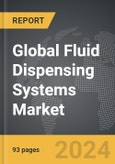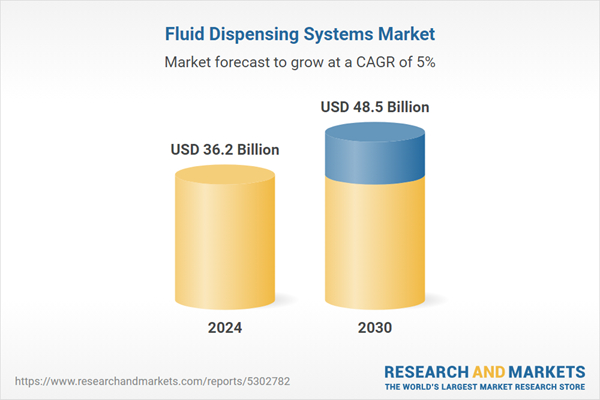Global Fluid Dispensing System Market - Key Trends & Drivers Summarized
Why Are Fluid Dispensing Systems Critical in Manufacturing and Industrial Processes?
Fluid dispensing systems are essential tools used in various manufacturing and industrial processes for precise application of liquids, adhesives, coatings, lubricants, and other fluids. These systems play a crucial role in industries like electronics, automotive, pharmaceuticals, aerospace, and packaging, where accuracy, efficiency, and consistency in fluid application are paramount. Whether it is depositing small amounts of adhesives on electronic components, applying lubricants in automotive assembly, or dispensing chemicals in pharmaceutical production, fluid dispensing systems ensure that materials are applied with precision, reducing waste and improving product quality. The increasing trend toward automation in manufacturing has further heightened the importance of fluid dispensing systems. As industries shift to more automated production lines, the need for reliable and consistent fluid dispensing solutions has grown. These systems can be integrated with robotic arms or other automated equipment, allowing manufacturers to speed up production, reduce human error, and maintain the consistency required for high-quality outputs. Additionally, the miniaturization of components in electronics and other fields demands highly accurate fluid dispensing, further driving the demand for advanced fluid dispensing systems.What Technological Advancements Are Shaping Fluid Dispensing Systems?
Technological advancements are playing a key role in enhancing the performance and efficiency of fluid dispensing systems. One of the most notable developments is the integration of smart technologies, such as sensors and digital control systems, into fluid dispensing equipment. These advancements allow for real-time monitoring and precise control over fluid flow, pressure, and volume, enabling manufacturers to optimize dispensing accuracy and consistency. Smart fluid dispensing systems can automatically adjust dispensing parameters based on data feedback, ensuring that the correct amount of fluid is applied in each cycle. This reduces material waste and improves overall process efficiency. Another significant innovation is the development of high-precision dispensing systems that can handle extremely small volumes of fluid, down to the microliter or even nanoliter scale. These systems are particularly important in industries like electronics and biotechnology, where precision is critical. In addition, advancements in valve technology have improved the ability of fluid dispensing systems to handle a wider range of viscosities, from thick adhesives to thin solvents. This versatility allows manufacturers to use the same dispensing system for multiple applications, further streamlining production processes. Additionally, new materials and designs in fluid dispensing nozzles and syringes have improved the durability and lifespan of dispensing equipment, reducing maintenance costs and downtime.Why Is the Demand for Automated and High-Precision Fluid Dispensing Systems Increasing?
The demand for automated and high-precision fluid dispensing systems is increasing due to the growing need for accuracy and efficiency in modern manufacturing processes. Industries such as electronics, automotive, and medical device manufacturing require precise control over fluid application to ensure product quality and reliability. For instance, in electronics manufacturing, fluid dispensing systems are used to apply solder paste, adhesives, and encapsulants with microliter precision to components on printed circuit boards (PCBs). Any deviation in the amount of fluid dispensed can result in defective products, leading to costly rework or failure in performance. The miniaturization of components and the complexity of modern electronics further drive the need for more accurate and controlled fluid dispensing solutions. In addition, the rise of automation in industrial processes has led to increased adoption of robotic and automated fluid dispensing systems. These systems offer numerous advantages, including higher production speeds, reduced labor costs, and improved consistency in fluid application. Automated fluid dispensing systems can operate continuously, with minimal supervision, while ensuring that each product receives the exact amount of fluid required. This is particularly important in high-volume manufacturing environments, where even small inefficiencies can result in significant cost overruns. The ability of these systems to work with a wide range of materials and viscosities also makes them attractive for manufacturers seeking to streamline operations.What Are the Key Growth Drivers in the Fluid Dispensing System Market?
The growth of the fluid dispensing system market is driven by several key factors, including the increasing demand for automation in manufacturing, the miniaturization of electronic components, and the need for precise and efficient fluid application in various industries. As industries adopt more automated production lines, the demand for reliable and consistent fluid dispensing systems is rising, particularly in sectors such as electronics, automotive, pharmaceuticals, and aerospace. The need for high-precision dispensing systems is also growing, especially in the electronics industry, where components are becoming smaller and more complex, requiring highly accurate fluid application for assembly and bonding processes. Furthermore, the trend toward reducing waste and improving production efficiency is driving the adoption of advanced fluid dispensing systems that can minimize material use while maintaining quality. In industries like pharmaceuticals and medical devices, where precision and hygiene are critical, fluid dispensing systems are essential for accurately dispensing chemicals, coatings, or adhesives to ensure product safety and performance. Technological advancements, such as the integration of digital control systems and smart sensors, are further propelling market growth by enhancing the capabilities of fluid dispensing systems and making them more adaptable to the evolving needs of modern manufacturing.Report Scope
The report analyzes the Fluid Dispensing Systems market, presented in terms of market value (US$ Thousand). The analysis covers the key segments and geographic regions outlined below.- Segments: System (Adhesives & Sealants, Lubricant, Conformal Coatings, Solder Paste, Flux, Other Systems); Application (Electrical & Electronics Assembly, Medical Devices, Transportation, Construction, Other Applications).
- Geographic Regions/Countries:World; United States; Canada; Japan; China; Europe (France; Germany; Italy; United Kingdom; Spain; Russia; and Rest of Europe); Asia-Pacific (Australia; India; South Korea; and Rest of Asia-Pacific); Latin America (Argentina; Brazil; Mexico; and Rest of Latin America); Middle East (Iran; Israel; Saudi Arabia; United Arab Emirates; and Rest of Middle East); and Africa.
Key Insights:
- Market Growth: Understand the significant growth trajectory of the Adhesives & Sealants segment, which is expected to reach US$18.3 Billion by 2030 with a CAGR of a 6.2%. The Lubricant segment is also set to grow at 4.2% CAGR over the analysis period.
- Regional Analysis: Gain insights into the U.S. market, valued at $9.5 Billion in 2024, and China, forecasted to grow at an impressive 7.6% CAGR to reach $10.5 Billion by 2030. Discover growth trends in other key regions, including Japan, Canada, Germany, and the Asia-Pacific.
Why You Should Buy This Report:
- Detailed Market Analysis: Access a thorough analysis of the Global Fluid Dispensing Systems Market, covering all major geographic regions and market segments.
- Competitive Insights: Get an overview of the competitive landscape, including the market presence of major players across different geographies.
- Future Trends and Drivers: Understand the key trends and drivers shaping the future of the Global Fluid Dispensing Systems Market.
- Actionable Insights: Benefit from actionable insights that can help you identify new revenue opportunities and make strategic business decisions.
Key Questions Answered:
- How is the Global Fluid Dispensing Systems Market expected to evolve by 2030?
- What are the main drivers and restraints affecting the market?
- Which market segments will grow the most over the forecast period?
- How will market shares for different regions and segments change by 2030?
- Who are the leading players in the market, and what are their prospects?
Report Features:
- Comprehensive Market Data: Independent analysis of annual sales and market forecasts in US$ Million from 2024 to 2030.
- In-Depth Regional Analysis: Detailed insights into key markets, including the U.S., China, Japan, Canada, Europe, Asia-Pacific, Latin America, Middle East, and Africa.
- Company Profiles: Coverage of players such as AdvanJet, Asymtek, Dymax Corporation, Fisnar Inc., GPD Global Inc. and more.
- Complimentary Updates: Receive free report updates for one year to keep you informed of the latest market developments.
Some of the 37 companies featured in this Fluid Dispensing Systems market report include:
- AdvanJet
- Asymtek
- Dymax Corporation
- Fisnar Inc.
- GPD Global Inc.
- Henkel AG & Co. KGaA
- Henline Adhesive Equipment Corporation
- Intertronics
- ITW Dynatec
- Musashi Engineering Inc.
- Nordson Corporation
- Protec Co., Ltd.
- Speedline Technologies
- Techcon Systems
- Valco Melton, Inc.
This edition integrates the latest global trade and economic shifts into comprehensive market analysis. Key updates include:
- Tariff and Trade Impact: Insights into global tariff negotiations across 180+ countries, with analysis of supply chain turbulence, sourcing disruptions, and geographic realignment. Special focus on 2025 as a pivotal year for trade tensions, including updated perspectives on the Trump-era tariffs.
- Adjusted Forecasts and Analytics: Revised global and regional market forecasts through 2030, incorporating tariff effects, economic uncertainty, and structural changes in globalization. Includes historical analysis from 2015 to 2023.
- Strategic Market Dynamics: Evaluation of revised market prospects, regional outlooks, and key economic indicators such as population and urbanization trends.
- Innovation & Technology Trends: Latest developments in product and process innovation, emerging technologies, and key industry drivers shaping the competitive landscape.
- Competitive Intelligence: Updated global market share estimates for 2025, competitive positioning of major players (Strong/Active/Niche/Trivial), and refined focus on leading global brands and core players.
- Expert Insight & Commentary: Strategic analysis from economists, trade experts, and domain specialists to contextualize market shifts and identify emerging opportunities.
Table of Contents
Companies Mentioned (Partial List)
A selection of companies mentioned in this report includes, but is not limited to:
- AdvanJet
- Asymtek
- Dymax Corporation
- Fisnar Inc.
- GPD Global Inc.
- Henkel AG & Co. KGaA
- Henline Adhesive Equipment Corporation
- Intertronics
- ITW Dynatec
- Musashi Engineering Inc.
- Nordson Corporation
- Protec Co., Ltd.
- Speedline Technologies
- Techcon Systems
- Valco Melton, Inc.
Table Information
| Report Attribute | Details |
|---|---|
| No. of Pages | 289 |
| Published | January 2026 |
| Forecast Period | 2024 - 2030 |
| Estimated Market Value ( USD | $ 36.2 Billion |
| Forecasted Market Value ( USD | $ 48.5 Billion |
| Compound Annual Growth Rate | 5.0% |
| Regions Covered | Global |









